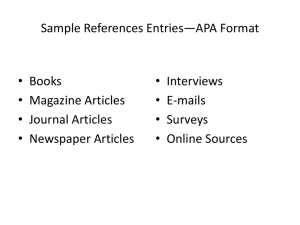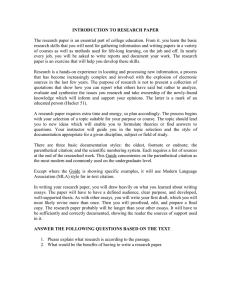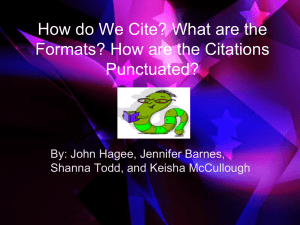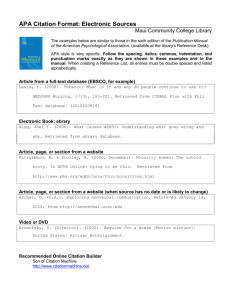APA (6th ed.)
advertisement
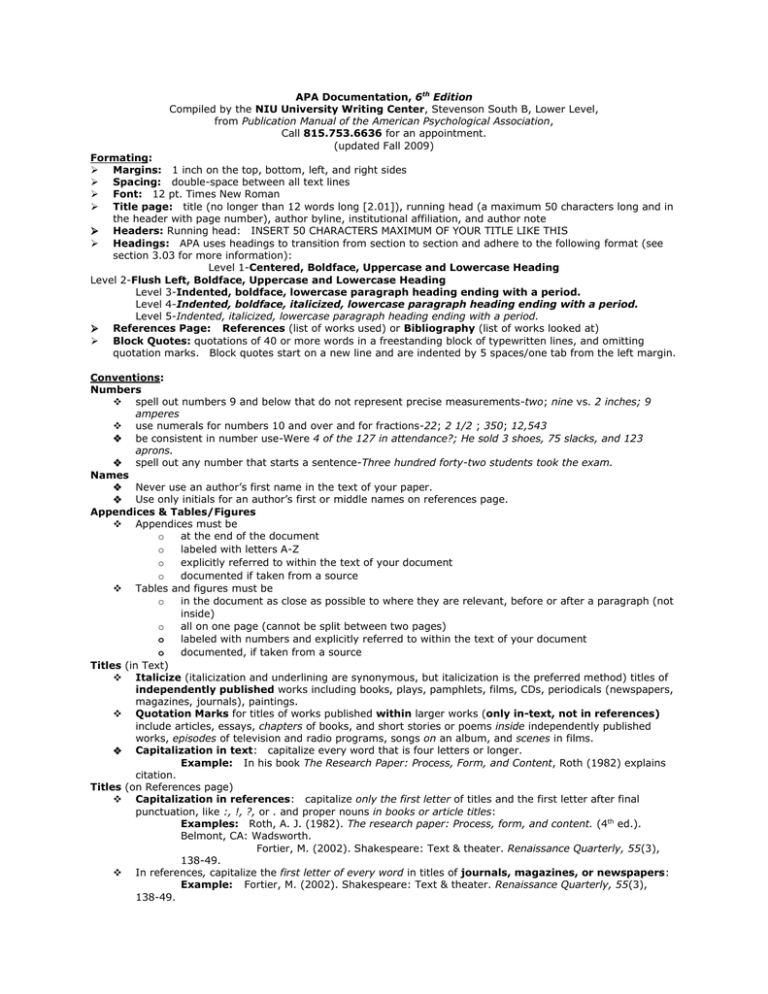
APA Documentation, 6th Edition Compiled by the NIU University Writing Center, Stevenson South B, Lower Level, from Publication Manual of the American Psychological Association, Call 815.753.6636 for an appointment. (updated Fall 2009) Formating: Margins: 1 inch on the top, bottom, left, and right sides Spacing: double-space between all text lines Font: 12 pt. Times New Roman Title page: title (no longer than 12 words long [2.01]), running head (a maximum 50 characters long and in the header with page number), author byline, institutional affiliation, and author note Headers: Running head: INSERT 50 CHARACTERS MAXIMUM OF YOUR TITLE LIKE THIS Headings: APA uses headings to transition from section to section and adhere to the following format (see section 3.03 for more information): Level 1-Centered, Boldface, Uppercase and Lowercase Heading Level 2-Flush Left, Boldface, Uppercase and Lowercase Heading Level 3-Indented, boldface, lowercase paragraph heading ending with a period. Level 4-Indented, boldface, italicized, lowercase paragraph heading ending with a period. Level 5-Indented, italicized, lowercase paragraph heading ending with a period. References Page: References (list of works used) or Bibliography (list of works looked at) Block Quotes: quotations of 40 or more words in a freestanding block of typewritten lines, and omitting quotation marks. Block quotes start on a new line and are indented by 5 spaces/one tab from the left margin. Conventions: Numbers spell out numbers 9 and below that do not represent precise measurements-two; nine vs. 2 inches; 9 amperes use numerals for numbers 10 and over and for fractions-22; 2 1/2 ; 350; 12,543 be consistent in number use-Were 4 of the 127 in attendance?; He sold 3 shoes, 75 slacks, and 123 aprons. spell out any number that starts a sentence-Three hundred forty-two students took the exam. Names Never use an author’s first name in the text of your paper. Use only initials for an author’s first or middle names on references page. Appendices & Tables/Figures Appendices must be o at the end of the document o labeled with letters A-Z o explicitly referred to within the text of your document o documented if taken from a source Tables and figures must be o in the document as close as possible to where they are relevant, before or after a paragraph (not inside) o all on one page (cannot be split between two pages) o labeled with numbers and explicitly referred to within the text of your document o documented, if taken from a source Titles (in Text) Italicize (italicization and underlining are synonymous, but italicization is the preferred method) titles of independently published works including books, plays, pamphlets, films, CDs, periodicals (newspapers, magazines, journals), paintings. Quotation Marks for titles of works published within larger works (only in-text, not in references) include articles, essays, chapters of books, and short stories or poems inside independently published works, episodes of television and radio programs, songs on an album, and scenes in films. Capitalization in text: capitalize every word that is four letters or longer. Example: In his book The Research Paper: Process, Form, and Content, Roth (1982) explains citation. Titles (on References page) Capitalization in references: capitalize only the first letter of titles and the first letter after final punctuation, like :, !, ?, or . and proper nouns in books or article titles: Examples: Roth, A. J. (1982). The research paper: Process, form, and content. (4th ed.). Belmont, CA: Wadsworth. Fortier, M. (2002). Shakespeare: Text & theater. Renaissance Quarterly, 55(3), 138-49. In references, capitalize the first letter of every word in titles of journals, magazines, or newspapers: Example: Fortier, M. (2002). Shakespeare: Text & theater. Renaissance Quarterly, 55(3), 138-49. Do not use quotation marks for titles on the references page. In-text Quotations and References: Author not introduced in sentence: Cite his/her name in your ending parenthetical reference. In-text parenthetical citation of paraphrased, summarized, or referenced material o Print sources: Author’s last name and year, separated by comma -- (Smith, 2004) o Source with no author listed: Substitute a shortened form of the title for the author - (Report, 2005) o Online sources: (same as print sources) Author’s last name and year -- (Smith, 2004) In-text parenthetical citation (paraphrased, summarized, or referenced) (provide page number in addition to name and year) o Print sources: Author’s last name, year, and page number -- (Smith, 2004, p. 34) o Quote that spans more than one page - use pp. instead of p. for page number - (Smith, 2004, pp. 98-100) o Source with no author listed: Substitute a shortened form of the title for the author - (Report, 2005, p. 57) o Online with paragraph numbered in original: Author’s last name, year, and paragraph number -(Smith, 2004, para. 11) o Online sources without paragraphs numbered or pagination in original: Author’s last name, year, the section heading, and the number of the paragraph the information came from: (Jones, 2005, Introduction, para. 1). In-text parenthetical citation of directly quoted material Only page or paragraph number in ending parenthetical citation: o According to Nance (2005), the best way to earn a good grade is “to study over the weekend” (p. 34). o In Nance’s (2005) study, participants earned better grades studying “over the weekend” (p. 34). Author introduced in sentence: Introduce the year of publication immediately after you mention the author’s name. In-text parenthetical citation (paraphrased, summarized, or referenced) No ending parenthetical citation is required: o According to Dewey (2004), correct citation is more important than students realize. o According to Dewey’s (2004) study, correct citation is more important than students realize. In-text parenthetical citation of directly quoted material Only page number is included in ending parenthetical citation: o According to Dewey (2004), “correct citation is more important than students realize” (p. 18). o According to Dewey’s (2004) study, “correct citation is more important than students realize” (p. 18). Indirect sources: (using a quote that appeared in a source you are using-in other words, a quote in a quote) For a source mentioned in your text, use the term as cited in o According to Dewey, “...” (as cited in Smith, 2005, p. 318). o Allport’s diary “...” (as cited in Nicholson, 2003). For a source not mentioned in your text, use original source’s name and as cited in o “...” (Dewey as cited in Smith, 2005, p. 318). o “...” (Allport as cited in Nicholson, 2003). NOTE: Make sure to use the hanging indent for 2nd and subsequent lines for each source in a reference list. Double space all entries in the reference list. Books, Book Chapters/Anthologies, and Reference Books: For an entire book, use one of these formats: Author, A. A. (Year). Title of work. Location: Publisher. Author, A. A. (Year). Title of work [Reader type if applicable]. Retrieved from http://www.xxxxxxxxxx Author, A. A. (Year). Title of work. doi:xxxxxxxxx Editor, A. A. (Ed.). (Year). Title of work. Location: Publisher. Entire book, print version Electronic version of print book Shotton, M. A. (1989). Computer addiction? A study of computer dependency. London, England: Taylor & Francis. Shotton, M.A. (1989). Computer addiction? A study of computer dependency [DX Reader version]. Retrieved from http://www.eboostore.tandf.co.uk/html/index.asp Electronic-only book Books chapter/item from an anthology Reference books Entry in an online reference work Entry in an online reference work, no author or editor O’Keefe, E. (n.d.). Egoism & the crisis in Western values. Retrieved from http://www.onlineoriginals.com/showitem.asp?itenID-135 Haybron, D. M. (2008). Philosophy and the science of subjective well-being. In M. Eid & R. J. Larsen (Eds.), The science of subjective well-being (pp. 17-43). New York, NY: Guilford Press. VandeBos, G. R. (Ed.). (2007). APA dictionary of psychology. Washington, DC: American Psychological Association. Graham, G. (2005). Behaviorism. In E. N. Zalta (Ed.), The Stanford encyclopedia of philosophy (Fall 2007 ed.). Retrieved from http://www.plato.stanfor.edu/entries/behavorism/ Heuristic. (n.d.). In Merrian-Webster’s online dictionary (11th ed.). Retrieved from http://www.m-w.com/dictionary/heuristic Periodicals: General reference form: Author, A. A., Author, B. B., & Author, C. C. (Year). doi:xxxxxxxxxx Journal article with DOI Journal article with issue number, print Electronic journal article with issue number Magazine article, print Online magazine Newspaper, print Online newspaper article Newspaper article with no author Title of article. Title of Periodical, xx, pp-pp. Herbst-Damm, K. L. & Kulik, J. A. (2005). Volunteer support, marital status, and the survival times of terminally ill patients. Health Psychology, 24, 225-229. doi:10.1037/0278-6133.24.2.225 Light, M. A., & Light, I. H. (2008). The geographic expansion of Mexican immigration in the United States and its implications for local law enforcement. Law Enforcement Executive Forum Journal, 8(1), 73-82. Silick, T. J., & Schutte, N. S. (2006). Emotional intelligence and self-esteem mediate between perceived early parental love and adult happiness. E-Journal of Applied Psychology, 2(2), 38-48. Retrieved from http://ojs.lib.swin.edu.au/index.php/ejab Chamberlin, J., Novotney, A., Packard, E., & Price, M. (2008, May). Enhancing worker well-being: Occupational health psychologists convene to share their research on work, stress, and health. Monitor on Psychology, 39(5), 26-29. Clay, R. (2008, June). Science vs. ideology: Psychologists fight back about the misuse of research. Monitor on Psychology, 39(6). Retrieved from http://www.apa.org/monitor Schwartz, J. (1993, September 30). Obesity affects economic, social status. The Washington Post, pp. A1, A4. Brody, J. E. (2007, December 11). Mental reserves keep brain agile. The New York Times. Retrieved from http://nytimes.com Six sites meet for comprehensive anti-gang initiative conference. (2006, November/December). OJJDP News @ a Glance. Retrieved from http://www.ncjrs.gov/html/ojjdp/news_at_glance/216684/topstory.html Technical and Research Reports: References for these types of sources appear much like books with the report number added in: Author, A. A. (Year). Title of work [Report No. xxx]. Location: Publisher. Corporate author, government report Authored report, from nongovernmental organization Report from institutional archive U.S. Department of Health and Human Services, National Institutes of Health, National Heart, Lung, and Blood Institute. (2003). Managing asthma: A guide for schools (NIH Publication No. 02-2650). Retrieved from http://www.nhlbi.nih.giv/health.prof/ling Kessy, S. S. A., & Urio, F. M. (2006). The contribution of microfinance institutions to poverty reduction in Tanzania (Research Report No. 06.3). Retrieved from Research on Poverty Alleviation website: http://www.repoa.or.tz/documents_storage/Publications/Reports/06.3_Kessy_and_Urio.pdf McDaniel, J. E., & Miskel, C. G. (2002). The effect of groups and individuals on national decisionmaking: Influence and domination in the reading policymaking environment (CIERA Report 3-025). Retrieved from University of Michigan, Center for Improvement of Early Reading Achievement website: http://www.ciera.org/library/reports/inquiry-3/3-025/3-025.pdf Meetings and Symposia: Symposium reference format: Contributor, A. A., Contributor, B. B., Contributor, C. C., & Contributor, D. D. (Year, Month). Title of contribution. In E. E. Chairperson (Chair), Title of symposium. Symposium conducted at the meeting of Organization Name, Location. Paper presentation or poster session: Presenter, A. A. (Year, Month). Title of paper or poster. Paper or poser session presented at the meeting of Organization Name, Location. Symposium contribution Conference paper abstract retrieved online Proceeding published regularly online Proceedings published in book form Muellbauer, J. (2007, September). Housing, credit, and consumer expenditure. In S. C. Ludvigsom (Chair), Housing and consumer behavior. Symposium conducted at the meeting of the Federal Reserve Bank of Kansas City, Jackson Hole, WY. Liu, S. (2005, May). Defending against business crises with the help of intelligent agent based early warning solutions. Paper presented at the Seventh International Conference on Enterprise Information Systems, Miami, FL. Abstract retrieved from http://www.iceis.org/iceis2005/abstracts_2005.html Herculano-Houzel, S., Collins, C. E., Wong, P., Kaas, J. H., & Lent, R. (2008). The basic uniformity of the cerebral cortex. Proceedings of the National Academy of Sciences 105, 12593-12598. doi:10.1073/pnas.0805417105 Katz, I., Gabayan, K., & Aghajan, H. (2007). A multi-touch surface using multiple cameras. In J. Blanc-Talon, W. Philips, D. Popescu, & P. Scheunders (Eds.), Lecture Notes in Computer Science: Vol. 4678. Advanced Concepts for Intelligent Vision Systems (pp. 97-108). Berlin, Germany: Springer-Verlag. doi:10.1007/978-3-540-74607-2_9 Doctoral Dissertations and Master’s Theses: For a dissertation or thesis available from a database service: Author, A. A. (2003). Title of dissertation or thesis (Doctoral dissertation or master’s thesis). Retrieved from Name of database. (Accession or Order No.) For an unpublished dissertation or thesis: Author, A. A. (1978). Title of dissertation or thesis (Unpublished doctoral dissertation or master’s thesis). Name of Institution, Location. Master’s thesis, from a commercial database Doctoral dissertation, from an institutional database Doctoral dissertation from the web McNeil, D. S. (2006). Meaning through narrative: A Personal narrative discussing growing up with an alcoholic mother (Master’s thesis). Available from ProQuest Dissertations and Theses database. (UMI No. 1434728) Adams, R. J. (1973). Building a foundation for evaluation of instruction in higher education and continuing education (Doctoral dissertation). Retrieved from http://www.ohiolink.edu/etd Bruckman, A. (1997). MOOSE Crossing: Construction, community, and learning in a networked virtual world for kids (Doctoral dissertation, Massachusettes Institued of Technology). Retrieved from http://www-static.cc.gatech.edu/~asb/thesis/ Audiovisual Media: For a motion picture: Producer, A. A. (Producer), & Director, B. B. (Director). Country of origin: Studio. (Year). Title of motion picture [Motion picture]. For a music recording: Writer, A. (Copyright year). Title of song [Recorded by B. B. Artist if different from writer]. On Title of album [Medium of recording: CD, record, cassette, etc.] Location: Label. (Date of recording if different from song copyright date) Video Podcast Single episode from a television series Music recording American Psychological Association. (Producer). (2000). Responding therapeutically to patient expressions of sexual attraction [DVD]. Available from http://www.apa.org/videos/ Van Nuys, D. (Producer). (2007, December 19). Shrink rap radio [Audio podcast]. Retrieved from http://www.shrinkrapradio.com/ Egan, D. (Writer), & Alexander, J. (Director). (2005). Failure to communicate [Television series episode]. In D. Shore (Executive producer), House. New York, NY: Fox Broadcasting. lang, k.d. (2008). Shadow and the frame. On Watershed [CD]. New York, NY: Nonesuch Records. Unpublished and Informally Published Works: This category also includes work that has not been formally published by is available on a personal or university website, an electronic archive such as ERIC, or a preprint archive. Author, A. A. (Year). Title of manuscript. Unpublished manuscript [or “Manuscript submitted for publication,” or “Manuscript in preparation”]. Unpublished manuscript with a university cited Manuscript in progress or submitted for publication Unpublished raw data from study, untitled work Blackwell, E., & Conrod, P. J. (2003). A five-dimensional measure of drinking motives. Unpublished manuscript, Department of Psychology, University of British Columbia, Vancouver, Canada. Ting, J. Y., Florsheim, P., & Huang, W. (2008). Mental health help-seeking in ethnic, minority populations: A theoretical perspective. Manuscript submitted for publication. Bordi, F., & LeDoux, J. E. (1993). [Auditory response latencies in rat auditory cortext]. Unpublished raw data. Internet Message Boards, Electronic Mailing Lists, and Other Online Communities: General reference form: Author, A. A. (Year, Month Day). Message posted to a newsgroup, online forum, or discussion group Blog post Video blog post Title of post [Description of form]. Retrieved from htpp://www.xxxx Rampersad, t. (2005, June 8). Re: Traditional knowledge and traditional cultureal expression [Online forum comment]. Retrieved from http://www.wipo.int/roller/comments/ipisforum/ Weblog/theme_eight_how_can_cultural#comments MiddleKid. (2007, January 22). Re: Disputed estimates of IQ [Electronic mailing list message]. Retrieved from http://tech.groups.yahoo.com/group/ForensicNetwork/670 Norton, R. (2006, November 4). How to train a cat to operate a light switch [Video file]. Retrieved from http://www.youtube.com/watch?v=Vja83KLQXZs Legal & Legislative Materials: List entry to a case Enacted federal bills and resolutions Lessard v. Schmidt, 349 F. Supp. 1078 (E.D. Wis. 1972). In-text: Lessard v. Schmidt (1972) or (Lessard v. Schmidt, 1972) S. Res. 107, 103d Cong., 139 Cong. Rec. 5826 (1993) (enacted). In-text: Senate Resolution 107 (1993) or (S. Res. 107, 1993)
